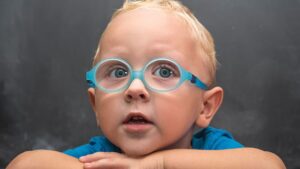The gift of sight is no doubt one of the most valuable gifts we can ever receive. We cherish our eyesight, and yet eye health is sometimes overlooked and neglected. Parenting may bring about many questions about eye care that haven’t previously crossed our mind.
When it comes to our children, we may sometimes be unsure as to what signs to watch for and when to be concerned that there may be a problem that needs to be examined. Our older children might be able to verbalize the trouble they’re having, while our younger children may communicate their needs differently.
Local pediatric optometrists Rena C. Lewis, O.D. of Narrows Eye Care and Calah Ray, O.D. of Vestavia Eye Care answer our questions about what to look for and when to bring a child for eye care.
Q: How do we know when our toddler needs glasses?
Lewis – “Infants and toddlers show several non-verbal cues to indicate vision problems. A youngster with nearsightedness (myopia) may get very close to the TV or hold objects close to his/her face. A child with excessive farsightedness (hyperopia) will have trouble focusing at near or will cross his/her eyes when looking at a near target. If a toddler sees better out of one eye, he/she may close the blurry eye or turn his/her head to favor the better seeing eye.”
Ray – “Toddlers aren’t always able to communicate verbally. I advise parents to monitor for squinting, eye rubbing when not tired, an eye turn which persists past six months of age, and developmental delays. If any of these are present, a comprehensive eye examination including dilation is indicated. However, in infants and toddlers, many eye-related conditions are asymptomatic. For example, a child with a significantly unequal glasses prescription (i.e. one eye needs glasses but the other does not) often displays no symptoms because the “good eye” is compensating for the “weak eye.” In this situation, parents are often surprised to learn their child needs glasses because he or she seems to see well.”
Q: What about the importance of early detection? Does it make a significant difference?
Lewis – “The earlier an optometrist detects a vision problem in a child, the better the outcome. Vision is a learned response. If you don’t use it, you lose it. The lack of stimulating the visual pathway is the process that causes amblyopia (lazy eye). Thankfully, early detection and treatment of eye problems in infants and toddlers typically have a very good prognosis.”
Ray – “Early detection and treatment are crucial for achieving the best possible visual outcome. Throughout the infant and toddler years, vision is developing rapidly. In order for vision to develop properly, each eye must have a focused image on the retina, the eyes must point in the same direction, and visual cortex must process the information properly. A breakdown in one of these areas can cause a lifelong impact on vision and learning. Uncorrected significant refractive error (glasses prescription) in an infant and toddler will translate to blurry vision (even with glasses) as an adult; this is called amblyopia. Additionally, blurry vision and/or inaccurate binocular vision (eye teaming) will hinder the development of stereopsis (depth perception), may cause developmental delays, and will impair early reading skills such as letter recognition.”
Q: What age is recommended for a first exam even when no problems are detected?
Lewis – “The Alabama Optometric Association recommends comprehensive eye exams for non-risk children at 6 months, 3 years and prior to starting first grade.”
Ray – “If the infant is symptom-free and there is no family history of eye problems, I recommend the first comprehensive eye exam be performed around nine months of age and then every two years or more frequently if indicated.”
Ray also shared information about the InfantSEE program, a public health program administered by the AOA Foundation. They provide a free comprehensive eye exam to infants between 6 and 12 months of age. More information, including a list of participating optometrists, can be found at www.infantsee.org.
Q: What about the family medical history and eye health issues?
Lewis – A family history of getting glasses at an early age, strabismus, amblyopia, congenital cataracts, retinoblastoma or genetic disease puts a child in a higher risk category. An infection such as herpes, cytomegalovirus, toxoplasmosis, and HIV may be passed to a baby during pregnancy and affect the eyes. Other high-risk factors for infants and toddlers include prematurely, oxygen at birth and central nervous system dysfunction.
Ray – A family history of strabismus (eye turn) or amblyopia (vision not correctable to 20/20) may increase the child’s chance of having the condition and warrants further investigation. However, many pediatric eye problems occur in children with no family history of the condition. An in-person, comprehensive eye exam including dilation is the most accurate way to fully assess the developing visual system of infants and toddlers.
Being aware of the signs and symptoms indicating eye health issues is the best place to begin. Consulting with your optometrist about any concerns you may have should be the next step. Thankfully, due to medical and scientific advancement, there are often multiple resources to help you feel confident that your child is seeing clearly and comfortably. After, all there is nothing quite as wonderful as the way a child sees the world.
Stephanie Rodda lives with her husband and children in the Birmingham area. She is an author and freelance writer. Her blog is located at StephanieRodda.wordpress.com.





